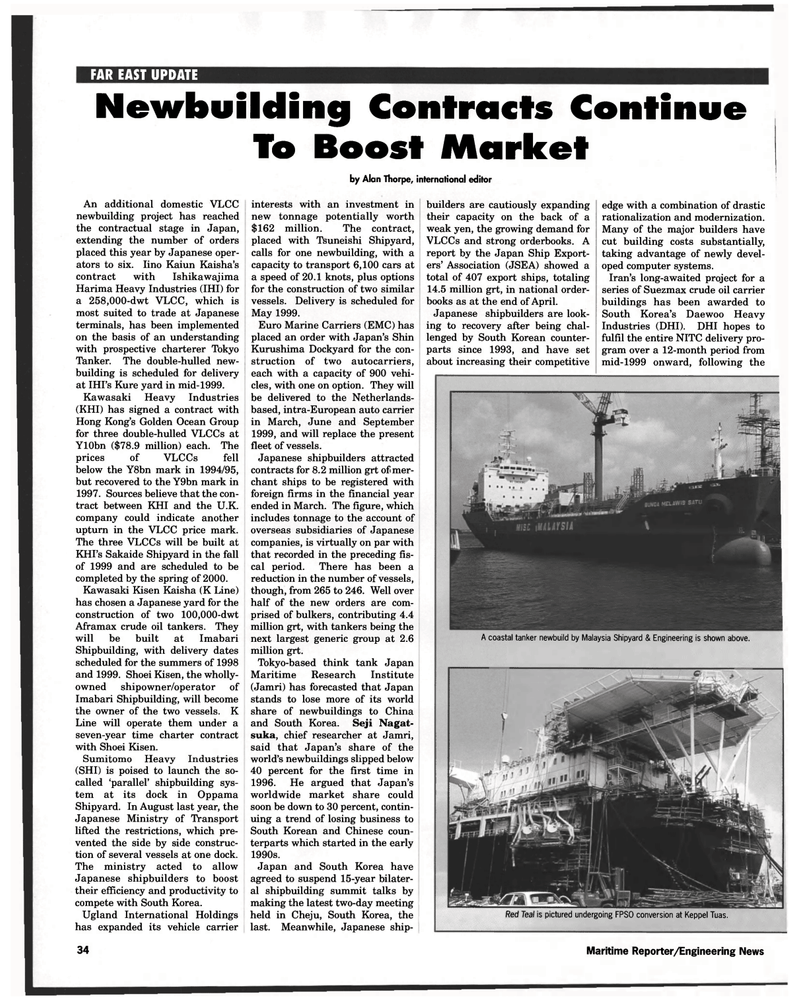
Page 34: of Maritime Reporter Magazine (August 1997)
Read this page in Pdf, Flash or Html5 edition of August 1997 Maritime Reporter Magazine
FAR EAST UPDATE
Newbuilding Contracts Continue
To Boost Market by Alan Thorpe, international editor
An additional domestic VLCC newbuilding project has reached the contractual stage in Japan, extending the number of orders placed this year by Japanese oper- ators to six. lino Kaiun Kaisha's contract with Ishikawajima
Harima Heavy Industries (IHI) for a 258,000-dwt VLCC, which is most suited to trade at Japanese terminals, has been implemented on the basis of an understanding with prospective charterer Tokyo
Tanker. The double-hulled new- building is scheduled for delivery at IHI's Kure yard in mid-1999.
Kawasaki Heavy Industries (KHI) has signed a contract with
Hong Kong's Golden Ocean Group for three double-hulled VLCCs at
YlObn ($78.9 million) each. The prices of VLCCs fell below the Y8bn mark in 1994/95, but recovered to the Y9bn mark in 1997. Sources believe that the con- tract between KHI and the U.K. company could indicate another upturn in the VLCC price mark.
The three VLCCs will be built at
KHI's Sakaide Shipyard in the fall of 1999 and are scheduled to be completed by the spring of 2000.
Kawasaki Kisen Kaisha (K Line) has chosen a Japanese yard for the construction of two 100,000-dwt
Aframax crude oil tankers. They will be built at Imabari
Shipbuilding, with delivery dates scheduled for the summers of 1998 and 1999. Shoei Kisen, the wholly- owned shipowner/operator of
Imabari Shipbuilding, will become the owner of the two vessels. K
Line will operate them under a seven-year time charter contract with Shoei Kisen.
Sumitomo Heavy Industries (SHI) is poised to launch the so- called 'parallel' shipbuilding sys- tem at its dock in Oppama
Shipyard. In August last year, the
Japanese Ministry of Transport lifted the restrictions, which pre- vented the side by side construc- tion of several vessels at one dock.
The ministry acted to allow
Japanese shipbuilders to boost their efficiency and productivity to compete with South Korea.
Ugland International Holdings has expanded its vehicle carrier interests with an investment in new tonnage potentially worth $162 million. The contract, placed with Tsuneishi Shipyard, calls for one newbuilding, with a capacity to transport 6,100 cars at a speed of 20.1 knots, plus options for the construction of two similar vessels. Delivery is scheduled for
May 1999.
Euro Marine Carriers (EMC) has placed an order with Japan's Shin
Kurushima Dockyard for the con- struction of two autocarriers, each with a capacity of 900 vehi- cles, with one on option. They will be delivered to the Netherlands- based, intra-European auto carrier in March, June and September 1999, and will replace the present fleet of vessels.
Japanese shipbuilders attracted contracts for 8.2 million grt of mer- chant ships to be registered with foreign firms in the financial year ended in March. The figure, which includes tonnage to the account of overseas subsidiaries of Japanese companies, is virtually on par with that recorded in the preceding fis- cal period. There has been a reduction in the number of vessels, though, from 265 to 246. Well over half of the new orders are com- prised of bulkers, contributing 4.4 million grt, with tankers being the next largest generic group at 2.6 million grt.
Tokyo-based think tank Japan
Maritime Research Institute (Jamri) has forecasted that Japan stands to lose more of its world share of newbuildings to China and South Korea. Seji Nagat- suka, chief researcher at Jamri, said that Japan's share of the world's newbuildings slipped below 40 percent for the first time in 1996. He argued that Japan's worldwide market share could soon be down to 30 percent, contin- uing a trend of losing business to
South Korean and Chinese coun- terparts which started in the early 1990s.
Japan and South Korea have agreed to suspend 15-year bilater- al shipbuilding summit talks by making the latest two-day meeting held in Cheju, South Korea, the last. Meanwhile, Japanese ship- builders are cautiously expanding their capacity on the back of a weak yen, the growing demand for
VLCCs and strong orderbooks. A report by the Japan Ship Export- ers' Association (JSEA) showed a total of 407 export ships, totaling 14.5 million grt, in national order- books as at the end of April.
Japanese shipbuilders are look- ing to recovery after being chal- lenged by South Korean counter- parts since 1993, and have set about increasing their competitive edge with a combination of drastic rationalization and modernization.
Many of the major builders have cut building costs substantially, taking advantage of newly devel- oped computer systems.
Iran's long-awaited project for a series of Suezmax crude oil carrier buildings has been awarded to
South Korea's Daewoo Heavy
Industries (DHI). DHI hopes to fulfil the entire NITC delivery pro- gram over a 12-month period from mid-1999 onward, following the
A coastal tanker newbuild by Malaysia Shipyard & Engineering is shown above.
Red Teal is pictured undergoing FPS0 conversion at Keppel Tuas. 34 Maritime Reporter/Engineering News

 33
33

 35
35
